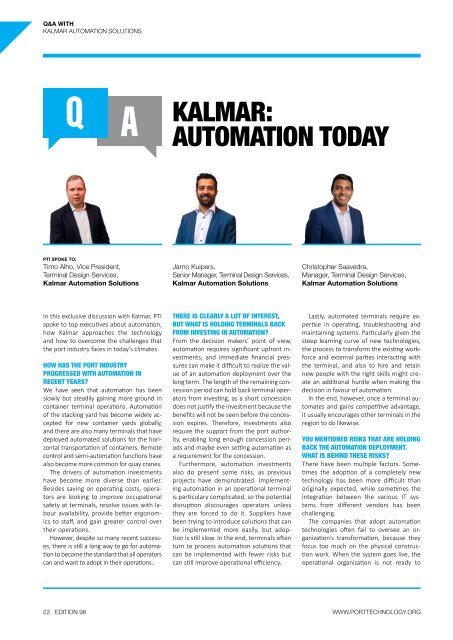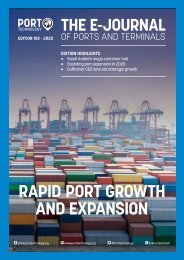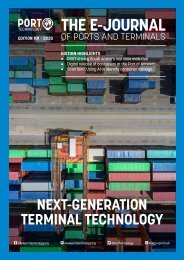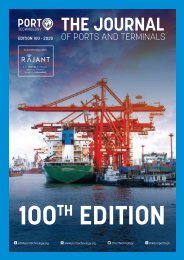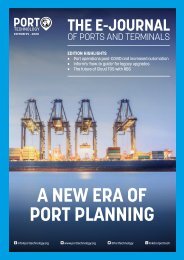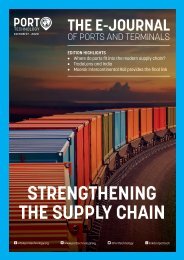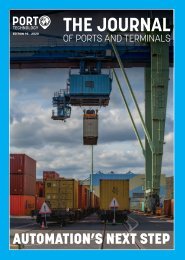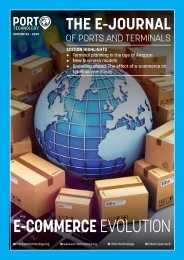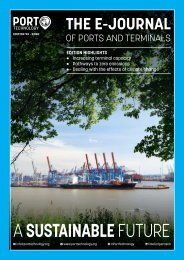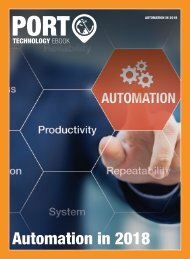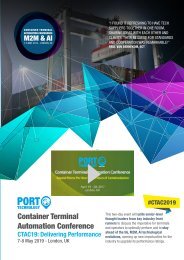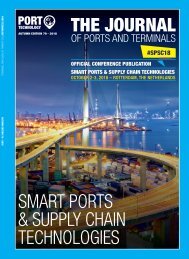Automation Innovations
As we enter the second half of 2020 the full effects of the COVID-19 pandemic are now being realised across the global economy and the port industry. For many, cargo throughput has been significantly decreasing compared with the same period for 2019. For example, the Port of Los Angeles handled 581,665 TEUs in May, a 29.8
As we enter the second half of 2020 the full effects of the COVID-19 pandemic are now being realised across the global economy and the port industry. For many, cargo throughput has been significantly decreasing compared with the same period for 2019.
For example, the Port of Los Angeles handled 581,665 TEUs in May, a 29.8
You also want an ePaper? Increase the reach of your titles
YUMPU automatically turns print PDFs into web optimized ePapers that Google loves.
Q&A WITH<br />
KALMAR AUTOMATION SOLUTIONS<br />
KALMAR:<br />
AUTOMATION TODAY<br />
PTI SPOKE TO:<br />
Timo Alho, Vice President,<br />
Terminal Design Services,<br />
Kalmar <strong>Automation</strong> Solutions<br />
Jarno Kuipers,<br />
Senior Manager, Terminal Design Services,<br />
Kalmar <strong>Automation</strong> Solutions<br />
Christopher Saavedra,<br />
Manager, Terminal Design Services,<br />
Kalmar <strong>Automation</strong> Solutions<br />
In this exclusive discussion with Kalmar, PTI<br />
spoke to top executives about automation,<br />
how Kalmar approaches the technology<br />
and how to overcome the challenges that<br />
the port industry faces in today’s climates.<br />
HOW HAS THE PORT INDUSTRY<br />
PROGRESSED WITH AUTOMATION IN<br />
RECENT YEARS?<br />
We have seen that automation has been<br />
slowly but steadily gaining more ground in<br />
container terminal operations. <strong>Automation</strong><br />
of the stacking yard has become widely accepted<br />
for new container yards globally,<br />
and there are also many terminals that have<br />
deployed automated solutions for the horizontal<br />
transportation of containers. Remote<br />
control and semi-automation functions have<br />
also become more common for quay cranes.<br />
The drivers of automation investments<br />
have become more diverse than earlier.<br />
Besides saving on operating costs, operators<br />
are looking to improve occupational<br />
safety at terminals, resolve issues with labour<br />
availability, provide better ergonomics<br />
to staff, and gain greater control over<br />
their operations.<br />
However, despite so many recent successes,<br />
there is still a long way to go for automation<br />
to become the standard that all operators<br />
can and want to adopt in their operations.<br />
THERE IS CLEARLY A LOT OF INTEREST,<br />
BUT WHAT IS HOLDING TERMINALS BACK<br />
FROM INVESTING IN AUTOMATION?<br />
From the decision makers’ point of view,<br />
automation requires significant upfront investments,<br />
and immediate financial pressures<br />
can make it difficult to realize the value<br />
of an automation deployment over the<br />
long term. The length of the remaining concession<br />
period can hold back terminal operators<br />
from investing, as a short concession<br />
does not justify the investment because the<br />
benefits will not be seen before the concession<br />
expires. Therefore, investments also<br />
require the support from the port authority,<br />
enabling long enough concession periods<br />
and maybe even setting automation as<br />
a requirement for the concession.<br />
Furthermore, automation investments<br />
also do present some risks, as previous<br />
projects have demonstrated. Implementing<br />
automation in an operational terminal<br />
is particulary complicated, so the potential<br />
disruption discourages operators unless<br />
they are forced to do it. Suppliers have<br />
been trying to introduce solutions that can<br />
be implemented more easily, but adoption<br />
is still slow. In the end, terminals often<br />
turn to process automation solutions that<br />
can be implemented with fewer risks but<br />
can still improve operational efficiency.<br />
Lastly, automated terminals require expertise<br />
in operating, troubleshooting and<br />
maintaining systems. Particularly given the<br />
steep learning curve of new technologies,<br />
the process to transform the existing workforce<br />
and external parties interacting with<br />
the terminal, and also to hire and retain<br />
new people with the right skills might create<br />
an additional hurdle when making the<br />
decision in favour of automation.<br />
In the end, however, once a terminal automates<br />
and gains competitive advantage,<br />
it usually encourages other terminals in the<br />
region to do likewise.<br />
YOU MENTIONED RISKS THAT ARE HOLDING<br />
BACK THE AUTOMATION DEPLOYMENT.<br />
WHAT IS BEHIND THESE RISKS?<br />
There have been multiple factors. Sometimes<br />
the adoption of a completely new<br />
technology has been more difficult than<br />
originally expected, while sometimes the<br />
integration between the various IT systems<br />
from different vendors has been<br />
challenging.<br />
The companies that adopt automation<br />
technologies often fail to oversee an organization’s<br />
transformation, because they<br />
focus too much on the physical construction<br />
work. When the system goes live, the<br />
operational organization is not ready to<br />
22 EDITION 98<br />
WWW.PORTTECHNOLOGY.ORG


